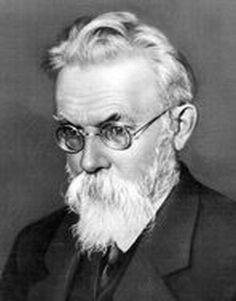Some Biogeographers, Evolutionists and Ecologists:
Chrono-Biographical Sketches
Vernadsky, Vladimir Ivanovich (Russia
1863-1945)
geochemistry, biochemistry, mineralogy
 from Wikipedia.org |
In his early years a student of Dokuchaev and Mendeleev and greatly inspired by their example, Vernadsky would go on to a career rivalling that of his teachers in fame and influence. Vernadsky has increasingly been recognized as an important pioneer in the area of "whole earth" studies; it was he, for example, who popularized the term "biosphere," and who revolutionized biogeochemical investigations by looking at related components not only in isolation, but as parts of ecosystems. He is also credited with starting the field of radiogeology. It was Vernadsky's belief that the biosphere as a whole was evolving, at once secondarily influencing geological evolution and slowly producing a new domain in which the human mind would become the dominant force, leading to a "noosphere." His numerous books and other publications treated related aspects of mineralogy, geochemistry, radioactivity, geology, crystallography, and soils. He was also a great teacher and international figure who travelled frequently outside of his homeland. Vernadsky's career was remarkable beyond the weight of his scientific accomplishments, moreover: despite his known anti-czarist and anti-Bolshevik sympathies, he somehow managed to navigate a political course through his life that neither got him into trouble with the ruling authorities, nor caused him to spend unintended time away from his studies. |
Life Chronology
--born in St. Petersburg, Russia, on 12 March 1863.
--1885: science degree, St. Petersburg University
--1886: made curator of the mineralogical collection at St. Petersburg
University
--1888-1890: travels widely outside Russia
--1890-1898: privat-dozent in mineralogy and crystallography, Moscow University
--1891: M.A., Moscow University, on the sillimanite group
--1897: Ph.D., Moscow University, on gliding in crystalline substances
--1898-1911: professor of crystallography and mineralogy, Moscow University
--1904: publishes his Osnovy Kristallografii (Fundamentals of
Crystallography)
--1908-1922: publishes his Opyt Opisatel'noy Mineralogii
(Experimental Descriptive Mineralogy)
--1910: leads first surveys for radium and uranium in Russia, making field
trips to the Crimea, Caucasus and Urals
--1910: publishes his Paragenezis Khimicheskikh Elementov v Zemnoy
Kore (Paragenesis of Chemical Elements in the Earth's Crust)
--1911: resigns professorship in protest, moves to St. Petersburg
--1912: elected academician to the St. Petersburg Academy of Sciences
--1914: made director of the Geological and Mineralogical Museum of the
Academy of Sciences; field trips to Lake Baikal and Transbaikalia
--1915-1917: president, Commission to Study the Natural Productive Forces
of Russia
--1917: moves to Kiev after the Bolshevik Revolution
--1918: founds the Biogeochemical Laboratory of the Academy of Sciences
(director 1920-1945)
--1919-1921: first president, Ukrainian Academy of Sciences
--1920-1921: rector, Tavrida (or Tauride or Taurida) University, Simferopol
--1921-1926: leaves Russia and lives in Paris
--1921-1939: founds and directs the State Radium Institute, Petrograd
--1922-1923: visiting professor at the Sorbonne and researcher at Marie
Curie's radium Institute
--1926: founds and heads the Commission on the History of Knowledge, Soviet
Academy of Sciences
--1926: publishes his Biosfera (The Biosphere)
--1926-1930: president, Commission to Study the Natural Productive Forces
of Russia
--1927: publishes his Istoriia Mineralov Zemnoy Kory (History
of the Minerals of the Earth's Crust)
--1927: publishes his Ocherki Geokhimii (Studies in Geochemistry);
French edition (La Géochimie) published in 1924
--1927-1945: founds and directs the Section on Living Substances, Academy
of Sciences
--1934: publishes his Problemy Biogeokhimii (Problems of Biogeochemistry)
--1937: founder and vice-president, International Commission to Determine
the Absolute Age of Geological Rocks by Radioactive Methods
--1940: publishes his Biogeokhimicheskie Ocherki (Biogeochemical
Sketches)
--1940-1945: chairman, Isotopes Commission
--1943: awarded the Stalin Prize
--dies at Moscow, on 6 January 1945.
--1945: posthumously publishes "The Biosphere and the Noösphere"
in American Scientist
For Additional Information, See:
--Geographers: Biobibliographical Studies, Vol. 7 (1983): 135-144.
--American Mineralogist, Vol. 32(3-4) (1947): 181-188.
--Nature, Vol. 155(3932) (1945): 296.
--Science,
Vol. 102(2653) (1945): 439-440.
--Archives Internationales d'Histoire des Sciences, Vol. 50(144)
(2000): 160-177.
--Impact of Science on Society, Vol. 38(151) (1988): 283-296.
--Russian Review, Vol. 40(3) (1981): 278-299.
--Dictionary of Scientific Biography, Vol. 13 (1976).
--Quarterly Review of
Biology, Vol. 70(2) (1995): 193-203.
--Slavic Review, Vol. 45(1) (1986): 20-37.
*
*
*
*
*
Copyright 2007 by Charles H. Smith. All rights reserved.
http://people.wku.edu/charles.smith/chronob/VERN1863.htm
Return to Home/Alphabetical Listing by Name
Return to Listing by Country
Return to Listing by Discipline